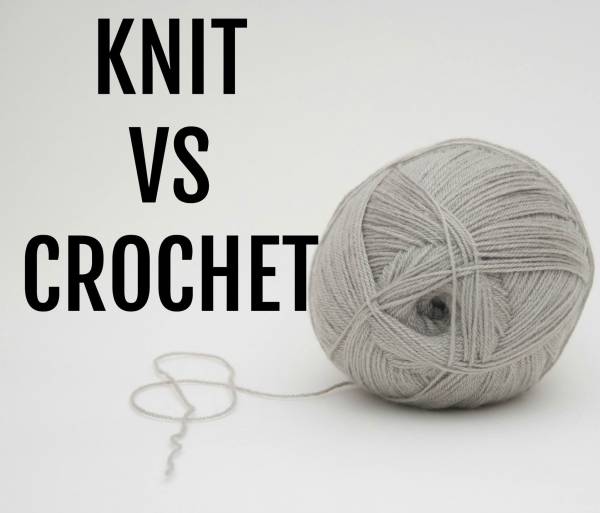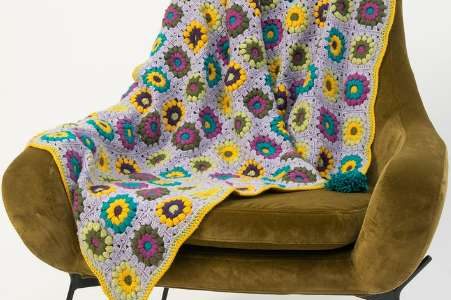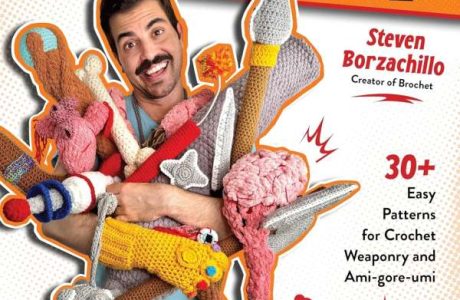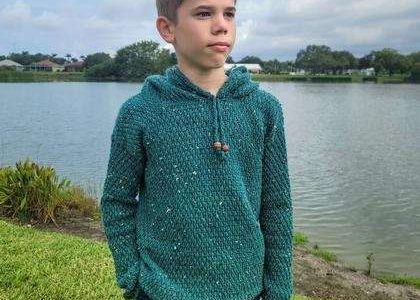
I think that Fernmonkey’s thoughtful ‘response’ to my recent blog “‘Is Crochet the Red-Headed Stepchild of Knitting?’” deserves to be read by all. So, although I could find no way to contact Fernmonkey personally, I’ve decided to elevate her to guest blog author status by posting her essay for all to read.
Here’s what Fernmonkey wrote:
First of all, I should point out that I’m referring to yarn crochet rather than thread crochet throughout. This is simply because most crocheters who get involved in the crochet v knit rivalry are talking about yarn crochet only, and in fact can be quite nasty about thread crochet (“crochet – it’s not just a load of old doilies!”).
Truth be told, I think that many yarn crocheters are as dismissive of thread crochet as knitters can be of crochet, but that’s a topic for another post. While thread crochet is relatively young compared to knitting (there’s no evidence of crochet before the 1800s), yarn crochet is an even newer form, originating in the post-WWII period. This doesn’t make yarn crochet any less legitimate as an art form – think of polymer clay, electronic music and digital graphics – but it does mean that there is very little historical tradition of wearing clothing which is entirely crocheted from yarn, as opposed to woven clothing (weaving is indeed much older than knitting) or knitted clothing. This means that people (especially male people) often have a very specific set of aesthetic expectations for the textural surfaces of their clothing – they must be of a smooth texture, a woven texture or a stockinette texture, because that is familiar and customary.
Crochet confounds these expectations. Crocheters tend to get terribly offended at the idea of putting crochet borders and edgings on knitted garments, but the aesthetic principle behind this is pretty sound familiar stockinette stitch provides a neutral background for the elaborate crocheted edgings, drawing the eye to things like the neckline and hands (and away from the belly and butt) and preventing the busyness that could result from a strongly textured crochet stitch being used throughout. I’m baffled as to how the use of crochet as as the visual highlight on a piece of knitwear is an insult to crochet, I have to say. The time when yarn-crochet clothing was most infamously fashionable was the 1970s, and I think that this has been a problem with the perception of crochet ever since.
Many 1970s fashions are not considered particularly attractive today (unlike, say, 1920s flapper fashions or the very tailored 1940s fashions of wartime) and thus the popular conception of crochet clothing became the green-and-brown-and-orange granny-square waistcoat, in unpleasant synthetic fibres (acrylic technology has improved since then). I should point out here that I’m not knocking granny squares per se – I think that they’re a sound way to make a blanket, given a quality washable yarn and a thoughtful choice of colours – but I don’t think they ever worked too well as wearables.
The resurgence of knitting (I’m going to call it the New American Knitting, because it happened in the US first) had a lot to do with Debbie Stoller’s Stitch & Bitch books, the first two of which were about knitting. I don’t have any proof of this, but I actually think that if Stoller had started out writing books about crochet, then it could have been the other way round, and I could have been commenting on a blog post entitled Is Knitting the Red-Headed Stepchild of Crochet?.
Most yarnworkers seem to start out by churning out large numbers of scarves, beanies, dishcloths and wristwarmers – and for projects of this type you’ll get pretty much equivalent results whether you knit or crochet, especially in the fluffy stitch-obscuring novelty yarns that seem to appeal to many novices. I should also point out here that the stylish knitting/dowdy crochet prejudice only exists within the yarnworking community, and in my experience it’s primarily within the New American Knitting community. Everyone else sees it all as this lame girlie hobby with yarn. If you don’t believe me, think of the way that everyone in the Harry Potter books reacts to knitted items with amusement, scorn or disdain. Think of the way everyone cracks jokes about getting a hideous hand-knit holiday sweater. The salmon may think himself mighty superior to the trout, but to everyone else, they’re both fish.
jd wolfe said: There are references to machine crochet when crochet cannot be done by machines – but knitting can!
I’ve been hearing crocheters say this for a very long time, and it confuses me, because a brief Google search shows dozens of (mostly Chinese) manufacturers of crochet machine. You can see some examples here.
Now, I don’t know very much about industrial textile production so I don’t know if these machines actually produce a woven or knit fabric that looks like crochet, but I don’t really think that one can look at all those listings and say that crochet (or at least crochet-looking) textiles can’t be made by machine.
Norah said: But they think it’s OK for baby garments for some reasons, maybe because there isn’t as much shaping needed in those.
This applies both to knit and crochet of course – even Debbie Bliss, a very eminent knitting designer, uses drop shoulders and boxy cuts for babywear. I think it’s because babies simply aren’t expected to wear figure-flattering shapely clothes. Babies don’t have day jobs or boyfriends, they wear diapers which are going to mess with any attempt at shaping whatsoever, and they don’t care about the armpit bulges that you get with drop sleeves. Also, tiny little set-in sleeves provide less scope for fun textures or colourwork than tiny little drop-shoulders.
Crochet really looks the best, especially for clothing, if done in yarns finer than worsted weight, but there are still a lot of bulky and chunky-weight garment patterns in crochet.
Totally agree on this, and I also think that the same is true for knitting, although to a lesser degree. Sweaters made up in bulky chunky yarn, whichever technique you use, do a great job of making the wearer look bulky and chunky. The problem is that yarnworkers like to see fast results, especially novices whose stitching rate is slow. It’s much easier to sell a n00b crocheter on a garment made out of Funky Chunky where you can see progress in minutes (check this out ‘Sally Harding Hooks’ for example), than it is to get them to do something in Skinny Minnie where you’ve been hooking away faithfully for an hour and you’ve still only got an inch or so of tiny, perfect stitches.
Using thin yarn tends to go against one of the main reasons that many people favour crochet over knitting, namely that crochet works up much faster (at least, it does for most people, including me). I think that people have to realise that there’s no shortcut – you can have quick’n’easy crochet, or you can have beautiful flattering crochet. If you want results as stunning as ‘Raspberry Fizz’ or ‘the Adventuring Sage Cable Vest’ (and I know the latter won’t please everyone style-wise, but the workmanship is fantastic, and those are the only crochet cables I’ve seen ANYWHERE that didn’t look like ass), you have to put in some work.
This leads me to another issue that I’ve noticed with yarn crochet. I think that yarn crocheters may be less likely to develop their skills to a high and sophisticated level than knitters, and less likely to use good yarn. If knitters who produce socks and sweaters in quality natural yarns only ever see crocheters who never make anything other than scarves and blankets, and never use anything other than the cheapest of acrylics, and who extol the superiority of crochet over knitting at the same time as only ever churning out scarves and blankets in the cheapest of acrylics, then they’re going to assume that yarn crochet is good for nothing more than acrylic scarves and blankets. (I use the cheapest of acrylics advisedly. Many of us make items which must be machine-washable to be useful – such as anything that will ever adorn a baby – and all of us have bills to pay. But there are nicer acrylics out there than Red Heart Super Saver, there are nice acrylic-cotton or acrylic-wool blends, there are superwash wools, and there are excellent-value natural-fibre yarns from elann, WEBS, Knitpicks and eBay.)
Basically, the only people who can improve crochet’s image are us crocheters. If you want knitting-oriented yarn stores to take crochet seriously, you yourself are going to have to ask them if you can order crochet books and magazines from them, ask them if they’d consider stocking a wider range of hooks, buy yarn from them and chat about what you’re going to crochet from it, and generally show them that the crochet dollar is there for the taking, and that crocheters don’t just use Wal-Mart yarn and free online patterns. What’s more, if you want to show people that crochet is capable of producing beautiful clothing, you yourself are going to have to crochet beautiful clothing, and wear it. I know that this is what you have to do because I’ve done it myself, and elicited reactions of ‘Wow, I didn’t know crochet could look like that!’
And it might mean that you have to splash out a little on better yarn (and if you value your crochet, don’t you want to show off your beautiful stitches in a beautiful yarn?), and it might mean that you have to persevere with thinner yarns and complex shaping, and it might mean that you have to work on the boring parts like swatching and making-up and blocking (unblocked crochet almost brings tears to my eyes, there is no better way to ruin lovely work), but nobody ever said that crocheting something worth wearing would be easy, and it’s a much better use of your time and energy than pissing and moaning about those elitist meaniepants knitters. And if you go to the S&B wearing Raspberry Fizz, or’ Kathy Merrick’s cardigan in Interweave Crochet” and the knitters still snub you, then it just goes to show that some people are so blinkered and prejudiced that you wouldn’t want them to accept you.
Check out our NEW Facebook page for Crochet. This page is only about Crochet!! Free pattern links, tips tricks and tutorial videos. We will be sharing it all to the ONE SPOT. Make sure you LIKE the new Crochet Facebook Page so you don’t miss out. Crochet Facebook Page.




Right on! I’m a yarn store owner, and although I stock plenty of books and magazines (alas, not many leaflet patterns for crocheters at this time) for crocheters, and mention to walk-ins the lovely yarns available to knitters AND crocheters, only 2 out of 100 customers admit to being crocheters. And only one I know of crochets sweaters or socks or other shaped garments. When I offer a crochet class, no one signs up!
FYI, Kathy Merrick’s cardigan in Interweave Crochet isn’t the item pictured. Her cardigan is the 7th one down in the Interweave Crochet preview page: http://www.interweavecrochet.com/2007/spring/materials_list.asp
Also I agree with pretty much everything Fernmonkey says and am so glad she said it. I’m one of the people who was complaining about knitters making fun of crocheters and crochet. I crochet with mostly natural or blend yarns that I get either in LYS’s, or at Elann or Knitpicks, and I mostly make clothing. Recently I’ve come to realize, through Josi Hannon Madera’s Art of Crochet site: http://www.weirdmirror.org/ and from my own experimentation that anything larger than DK weight just doesn’t work that well for crocheted clothing–it makes a boxy garment that adds width to anyone wearing it no matter how thin they may be.
It’s just disappointing to hear people say “Oh, crochet isn’t for clothing” when the only types of crocheted clothing they’ve seen are boxy drop-shouldered items or plasticky acrylic from the 70’s, but there are now a few things that we can point them to that show what crochet can be if done correctly.
I didn’t mean “correctly” in the last sentence–that makes it seem like there’s a only one way and sounds really rigid. I meant if someone wants to crochet clothing, if they use patterns that use smaller yarn and do swatching, choose patterns with flattering shapes, etc. and block the finished product, and use a little nicer yarn, crochet can look as good as knitting for clothing. (
Just like if you knit with big bulky stiff yarn in a boxy shape, it’ll look as bad on you or your recipient as any crochet could!)
Fernmonkey said: “This is simply because most crocheters who get involved in the “crochet v knit†rivalry are talking about yarn crochet only, and in fact can be quite nasty about thread crochet (â€crochet – it’s not just a load of old doilies!â€).
My experience would disagree with this assumption. Those who don’t do thread/lace crochet find it more intimidating and it challenging. We love the beauty, but have troubles reconciling the beauty with the necessity of making our crochet practical, in order to justify the expense.
“Truth be told, I think that many yarn crocheters are as dismissive of thread crochet as knitters can be of crochet, but that’s a topic for another post.”
Again, my experience does not support this assumption. Yarnies marvel at the beauty of Thread Crochet, but practicality and difficulty prevent them from acutally trying it.
“jd wolfe said: There are references to machine crochet when crochet cannot be done by machines – but knitting can!
I’ve been hearing crocheters say this for a very long time, and it confuses me, because a brief Google search shows dozens of (mostly Chinese) manufacturers of “crochet machinesâ€. You can see some examples here: http://www.b2bchinasources.com/China-Manufacturers-58/Crochet-Machines.html”
Yes, we’ve all seen the claims for Crochet Machines, and at best, they can only do Slip Stitch Edgings. Beyond this simple stitch, the mechanics of Crochet make it impossible to replicate with a machine. It simply cannot be done by machine. Those beautiful doilies and lace work on clothing are done by peasants in 3rd world countries who are paid only pennies for each piece they complete.
Given the fact that so many folks confuse crochet with knitting, within the mainstream media- the two terms are interchangable. Companies may claim they have crochet machines, but they either create a knitted fabric, or the slip stitch edging.
“While thread crochet is relatively young compared to knitting (there’s no evidence of crochet before the 1800s), yarn crochet is an even newer form, originating in the post-WWII period.”
My resources and research, again, disprove or offer better clarification for these statements.
The earliest written record of crochet is from the 1700’s (100 years ealier than what FernMonkey reported), and was called “PJoining.” Done all in slip stitches, this was an adaptation of Tambour en Air; a type of needlework in which loops are pulled through a mesh fabric and interconnected. When this method travel from Arabia by trade routes, someone in Europe realized that if the loops were worked together, the mesh fabric could be eliminated.
The oldest remaining piece of crochet is from the 1720’s. Needlework historians attribute this lack of physical evidence to the fact that needleoworkers could easily dismantle crocheted items and rework the thread/yarn into a new piece.
As for crocheting with yarn, I have hundreds of Victorian Era crochet patterns that use yarn for everything from an infant’s diaper cover to skirts and jackets, as well as, blankets, pillows, chair covers and couverpieds. Look for Weldon’s Practical Crochet, or Godey’s Lady’s Book or Petersen’s Magazine for patterns in the 1800’s that actually use yarn.
As for needlework making a resurgence, I am dumbfounded when folks make this statement. Resurgence? It never left. One of the reasons that I turned to writing crochet, instead of selling finished pieces is because my area of the world is saturated with folks who knit, crochet and do cross stitch or needlepoint.
Just because mainstream media or publishing industry want to make needlework hip for the younger generations by claiming it’s making a comeback, does not make these claims true.
Needlework of all kinds have been popular in the US, for generations. Granted, not everyone in a family would learn all the needlearts, but everyone in a family learned at least one of them.
Personally, I see the industry as just waking up to the profit potential of what was already there: a huge number of people clamoring for needlework products and so few companies stepping up to supply that need.
I’m not trying to dismiss Fernmonkey’s or any other commenters’ thoughts and beliefs; they just don’t follow what my research has discovered.
Knitters and the industry in general snub crocheters for not using expensive yarns. Many of us want to know why yarn companies snub us, instead of catering to us. We want a decent quality yarn for a good price, and since we need half a ton of it, why not offer it at bulk prices.
Crocheters are pracitcal, economical, and although they are passionate about crochet, they must justify spending money on a hobby. This is why they crochet so many utilitarian objects like blankets, scarves and hats.
I could go on for days on this topic, and I already have. Rather than waste more space here, I will provide a link to My article at my site:
http://www.chezcrochet.com/page87.html
NORAH – Thanks so much for pointing this out. I want to ALWAYS give credit to the crocheter &/0r designer.
FYI, Kathy Merrick’s cardigan in Interweave Crochet isn’t the item pictured. Her cardigan is the 7th one down in the Interweave Crochet preview page: http://www.interweavecrochet.com/2007/spring/materials_list.asp
THANKS for all the good commments. Arnie always has good information – so I pay attention.
I love to learn at least one new crochet thing every day – and you never let me down!
jd